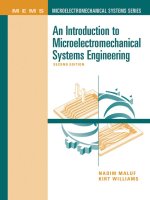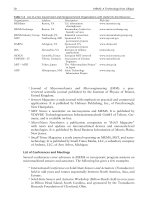An Introduction to Microelectromechanical Systems Engineering potx
Bạn đang xem bản rút gọn của tài liệu. Xem và tải ngay bản đầy đủ của tài liệu tại đây (3.32 MB, 180 trang )
Simpo PDF Merge and Split Unregistered Version -
An Introduction to
Microelectromechanical
Systems Engineering
Second Edition
Simpo PDF Merge and Split Unregistered Version -
For a listing of recent titles in the Artech House Microelectromechanical
Systems (MEMS) Series, turn to the back of this book.
Simpo PDF Merge and Split Unregistered Version -
An Introduction to
Microelectromechanical
Systems Engineering
Second Edition
Nadim Maluf
Kirt Williams
Artech House, Inc.
Boston • London
www.artechhouse.com
Simpo PDF Merge and Split Unregistered Version -
Library of Congress Cataloging-in-Publication Data
A catalog record for this book is available from the U.S. Library of Congress.
British Library Cataloguing in Publication Data
Maluf, Nadim.
An Introduction to microelectromechanical systems engineering–2nd ed. –(Artech House
microelectromechanical library)
1. Microelectromechanical systems
I. Title II. Williams, Kirt
621.3’81
ISBN 1-58053-590-9
Cover design by Igor Valdman
© 2004 ARTECH HOUSE, INC.
685 Canton Street
Norwood, MA 02062
All rights reserved. Printed and bound in the United States of America. No part of this book
may be reproduced or utilized in any form or by any means, electronic or mechanical, includ-
ing photocopying, recording, or by any information storage and retrieval system, without
permission in writing from the publisher.
All terms mentioned in this book that are known to be trademarks or service marks have
been appropriately capitalized. Artech House cannot attest to the accuracy of this informa
-
tion. Use of a term in this book should not be regarded as affecting the validity of any trade
-
mark or service mark.
International Standard Book Number: 1-58053-590-9
10987654321
Simpo PDF Merge and Split Unregistered Version -
To our families
Tanya, Ella, and Jad
Erika, Gordon, Brynn, and Reed
Simpo PDF Merge and Split Unregistered Version -
.
Simpo PDF Merge and Split Unregistered Version -
Contents
Foreword xiii
Preface xv
Preface to First Edition xix
CHAPTER 1
MEMS: A Technology from Lilliput 1
The Promise of Technology 1
What Are MEMS—or MST? 2
What Is Micromachining? 3
Applications and Markets 4
To MEMS or Not To MEMS? 7
Standards 8
The Psychological Barrier 8
Journals, Conferences, and Web Sites 9
List of Journals and Magazines 9
List of Conferences and Meetings 10
Summary 11
References 11
Selected Bibliography 12
CHAPTER 2
Materials for MEMS 13
Silicon-Compatible Material System 13
Silicon 13
Silicon Oxide and Nitride 19
Thin Metal Films 20
Polymers 21
Other Materials and Substrates 21
Glass and Fused Quartz Substrates 21
Silicon Carbide and Diamond 22
Gallium Arsenide and Other Group III-V Compound Semiconductors 22
Polymers 23
Shape-Memory Alloys 23
Important Material Properties and Physical Effects 24
vii
Simpo PDF Merge and Split Unregistered Version -
Piezoresistivity 24
Piezoelectricity 26
Thermoelectricity 29
Summary 31
References 31
Selected Bibliography 32
CHAPTER 3
Processes for Micromachining 33
Basic Process Tools 34
Epitaxy 34
Oxidation 35
Sputter Deposition 35
Evaporation 36
Chemical-Vapor Deposition 37
Spin-On Methods 40
Lithography 40
Etching 44
Advanced Process Tools 55
Anodic Bonding 55
Silicon Direct Bonding 56
Grinding, Polishing, and Chemical-Mechanical Polishing 57
Sol-Gel Deposition Methods 58
Electroplating and Molding 58
Supercritical Drying 60
Self-Assembled Monolayers 61
SU-8 Photosensitive Epoxy 61
Photosensitive Glass 62
EFAB 62
Nonlithographic Microfabrication Technologies 63
Ultraprecision Mechanical Machining 64
Laser Machining 64
Electrodischarge Machining 65
Screen Printing 65
Microcontact Printing/Soft Lithography 66
Nanoimprint Lithography 67
Hot Embossing 67
Ultrasonic Machining 68
Combining the Tools—Examples of Commercial Processes 68
Polysilicon Surface Micromachining 69
Combining Silicon Fusion Bonding with Reactive Ion Etching 71
DRIE of SOI Wafers 71
Single Crystal Reactive Etching and Metallization 72
Summary 74
References 75
Selected Bibliography 77
viii Contents
Simpo PDF Merge and Split Unregistered Version -
CHAPTER 4
MEM Structures and Systems in Industrial and Automotive Applications 79
General Design Methodology 79
Techniques for Sensing and Actuation 81
Common Sensing Methods 81
Common Actuation Methods 82
Passive Micromachined Mechanical Structures 85
Fluid Nozzles 85
Hinge Mechanisms 88
Sensors and Analysis Systems 89
Pressure Sensors 89
High-Temperature Pressure Sensors 93
Mass Flow Sensors 94
Acceleration Sensors 96
Angular Rate Sensors and Gyroscopes 104
Carbon Monoxide Gas Sensor 114
Actuators and Actuated Microsystems 116
Thermal Inkjet Heads 116
Micromachined Valves 119
Micropumps 126
Summary 128
References 129
Selected Bibliography 131
CHAPTER 5
MEM Structures and Systems in Photonic Applications 133
Imaging and Displays 133
Infrared Radiation Imager 133
Projection Display with the Digital Micromirror Device
TM
135
Grating Light Valve™ Display 139
Fiber-Optic Communication Devices 141
Tunable Lasers 142
Wavelength Locker 151
Digital M × N Optical Switch 154
Beam-Steering Micromirror for Photonic Switches and Cross Connects 156
Achromatic Variable Optical Attenuation 161
Summary 165
References 165
Selected Bibliography 167
CHAPTER 6
MEMS Applications in Life Sciences 169
Microfluidics for Biological Applications 169
Pumping in Microfluidic Systems 170
Mixing in Microfluidics 171
DNA Analysis 172
Contents ix
Simpo PDF Merge and Split Unregistered Version -
The Structure of DNA 172
PCR 174
PCR on a Chip 174
Electrophoresis on a Chip 176
DNA Hybridization Arrays 180
Microelectrode Arrays 182
DNA Addressing with Microelectrodes 183
Cell Cultures over Microelectrodes 185
Summary 185
References 186
Selected Bibliography 187
CHAPTER 7
MEM Structures and Systems in RF Applications 189
Signal Integrity in RF MEMS 189
Passive Electrical Components: Capacitors and Inductors 190
Quality Factor and Parasitics in Passive Components 190
Surface-Micromachined Variable Capacitors 192
Bulk-Micromachined Variable Capacitors 195
Micromachined Inductors 197
Microelectromechanical Resonators 200
Comb-Drive Resonators 201
Beam Resonators 203
Coupled-Resonator Bandpass Filters 206
Film Bulk Acoustic Resonators 208
Microelectromechanical Switches 211
Membrane Shunt Switch 213
Cantilever Series Switch 213
Summary 214
References 214
Selected Bibliography 216
CHAPTER 8
Packaging and Reliability Considerations for MEMS 217
Key Design and Packaging Considerations 218
Wafer or Wafer-Stack Thickness 219
Wafer Dicing Concerns 219
Thermal Management 220
Stress Isolation 221
Protective Coatings and Media Isolation 222
Hermetic Packaging 223
Calibration and Compensation 224
Die-Attach Processes 225
Wiring and Interconnects 227
Electrical Interconnects 227
Microfluidic Interconnects 231
Optical Interconnects 232
x Contents
Simpo PDF Merge and Split Unregistered Version -
Types of Packaging Solutions 233
Ceramic Packaging 233
Metal Packaging 237
Molded Plastic Packaging 240
Quality Control, Reliability, and Failure Analysis 243
Quality Control and Reliability Standards 244
Statistical Methods in Reliability 246
Accelerated Life Modeling 248
Major Failure Modes 249
A Reliability Case Study: The DMD 254
Summary 256
References 257
Selected Bibliography 259
Glossary 261
About the Authors 271
Index 273
Contents xi
Simpo PDF Merge and Split Unregistered Version -
.
Simpo PDF Merge and Split Unregistered Version -
Foreword
According to my best recollection, the acronym for microelectromechanical systems
(MEMS) was officially adopted by a group of about 80 zealots at a crowded meet
-
ing in Salt Lake City in 1989 called the Micro Tele-Operated Robotics Workshop. I
was there to present an invited paper that claimed MEMS should be used to fabri
-
cate resonant structures for the purposes of timekeeping, and I was privileged to be
part of this group of visionaries for one and a half exciting days. The proceedings
may not be in print any longer. However, I recall that they were given an Institute of
Electrical and Electronic Engineers (IEEE) catalog number of 89TH0249-3. Discus
-
sion at the workshop about the name of this new field of research raged for over an
hour, and several acronyms were offered, debated, and rejected. When the dust set
-
tled, I recall that Professor Roger Howe of the University of California at Berkeley
stood up and announced, “Well, then, the name is MEMS.” In this way, the group
came to consensus. The research they conducted, unique to any currently being con-
ducted in the United States (or the world for that matter) would hereafter be known
as “MEMS.”
In those early, heady, exciting, and terribly uncertain days, many issues faced
those in the nascent field that researchers today would find hard to remember. For
example, our hearty band constantly worried if any scholarly journal would publish
the papers we wrote. Sources of research funding were hard to find and difficult to
maintain. MEMS fabrication was itself a major issue. Topics of conversation were
frequently about the nature, properties, and standardization of the polysilicon that
the pioneering band of researchers was using to demonstrate the early, elementary
structures of the day. Even the most daring and idealistic of students occasionally
turned down the offer to work with the faculty of that era: the work sometimes
appeared too farfetched for the taste of even the green-eyed zealots among the
graduate student population.
In the 10 years since the momentous events of that watershed workshop, the
National Science Foundation (NSF) funded a set of MEMS projects under its
“Emerging Technologies Initiative,” headed at the time by George Hazelrigg. NSF
funding continues to this day. The Defense Advanced Projects Research Agency
(DARPA) put nearly $200 million into MEMS research. Numerous MEMS journals
have sprung up, and the rate of filing of MEMS patents has reached over 160 per
calendar year in 1997. The skeptics that predicted the collapse of the field in 1990
are now confronted with the fact that, in 1997, 80 U.S. were companies in the
MEMS field. The combined total world market of MEMS reached approximately
$2 billion as well. In addition, the most conservative market studies predict a world
MEMS market in excess of $8 billion in 2003. In a phrase, MEMS has arrived.
xiii
Simpo PDF Merge and Split Unregistered Version -
Despite all the rosy news, there remain significant challenges facing the MEMS
field. One of these I call the challenge of the “500 MEMS Companies” and the other,
the “10,000 MEMS Designers.” For the field to fully take root and become ubiqui
-
tous, there must be an unprecedented training of tens of thousands of MEMS engi
-
neers. Already, the demand for MEMS experts has far outstripped the ability of
academia to train them. The only hope is for existing engineers to learn the basics of
MEMS and then go up the MEMS learning curve in the traditional way (i.e., learn
-
ing by doing).
Here is where this book plays an important, essential role on the national stage.
Dr. Nadim Maluf has put together one of the finest MEMS primers that you may
find on the bookshelf today. Written in a no-nonsense, clear style, the book brings
the practicing engineer and student alike to an understanding of how MEMS are
designed and fabricated. Dr. Maluf’s book concentrates mostly on how to design
and manufacture MEMS. This is to be expected of Dr. Maluf, who has impeccable
MEMS credentials. Trained in MEMS for his Ph.D. at Stanford University, Dr.
Maluf has spent his postdoctoral career as a practicing MEMS engineer and man
-
ager at Lucas NovaSensor, one of the early MEMS companies in the field. His indus
-
trial career has been focused both on bringing MEMS products successfully to
market and on defending his company’s market share against encroachment by
other technologies. Because this book is written from Dr. Maluf’s practical perspec-
tive, this volume is sure to have lasting value to the myriad of engineers and execu-
tives who are struggling to find a way into the field of MEMS. This book also will
serve as a useful resource for those already in the field who wish to broaden their
expertise in MEMS fabrication. When I reviewed the manuscript, I was ready to
offer Dr. Maluf a great deal of suggestions and corrections. I was quite humbled to
realize that, instead, I was eager to have a copy of the new book on my own shelf. It
will serve as a reference for not only myself, but also the students and engineers who
frequently ask me, “What book should I buy to learn how to make MEMS?”
Albert (“Al”) P. Pisano, Ph.D.
MEMS Program Manager
DARPA
xiv Foreword
Simpo PDF Merge and Split Unregistered Version -
Preface
The past few years have witnessed an increasing maturity of the MEMS industry
and a rapid introduction of new products addressing applications ranging from bio
-
chemical analysis to fiber-optic telecommunications. The market size for MEMS
products has doubled in the past 5 years and is projected to grow at this fast rate for
the foreseeable future. The corresponding technology has enjoyed a fast pace of
development and has rapidly spread to institutions and companies on all inhabited
continents. A search of the keyword MEMS in all granted patents in the United
States since 1998 returns nearly 4,000 patents and references. Many devices have
left universities to go into commercial development, and several have reached the
stage of becoming products. It is therefore appropriate to extensively revise the text
to incorporate advances in the field, new products, as well as suggestions from the
readers.
As we revised the original text and added substantial new material, we strived to
retain the style characteristic of an introductory book intended for a broad audience
of scientists, engineers, students, and business executives. This revised edition con-
tinues to assume that the reader has no prior experience in MEMS technology but
does possess an understanding of basic scientific concepts equivalent to first-year
college physics and chemistry. The objective remained to introduce a select number
of representative demonstrators that are now or are soon to be commercially avail-
able. We added many more illustrations and pictures to aid the reader in developing
a familiarity with the technology. We also included throughout the text more practi-
cal tidbits that are useful to those who wish to apply this technology to their needs.
In this revision, we have expanded on the fabrication processes, adding new
methods and materials. The advantages and limitations of many micromachined
structures are covered in more detail. We divided the chapter on commercial struc
-
tures into four chapters, each focusing on a specific application, and then expanded
each chapter with appropriate material covering new technical developments and
products. Chapter 4 is now specific to automotive and industrial applications, cov
-
ering traditional products, such as pressure sensors, accelerometers, and yaw-rate
sensors, and new emerging products in valving and pumping. Chapter 5 now covers
the applications of MEMS in photonics, including displays, optical sensors, and
new products that are now common in fiber-optic telecommunications. The focus
of Chapter 6 is on applications in life sciences, with emphasis on new products and
developments specific to biochemical analysis and microfluidics. With the emer
-
gence of wireless and radio frequency (RF) as a new market for MEMS technology,
we dedicated Chapter 7 to describe recent developments and introductions in this
promising area. In Chapters 4 through 7, we expanded where appropriate on the
xv
Simpo PDF Merge and Split Unregistered Version -
application and on the system that includes the MEMS product. We also expanded
the material in Chapter 8 on packaging to include packaging of optical MEMS prod
-
ucts and added an entirely new section on reliability and quality assurance. We
added several references to each chapter to direct the advanced reader to the source
of the material. We also expanded the glossary to assist the novice in understanding
and relating to a new terminology.
Many people provided us technical information and materials specifically for
the second edition of this book. We thank Bardia Pezeshki of Santur Corporation;
John (Hal) Jerman of Iolon; Asif Godil of Lightconnect; Greg Ortiz of Surface Tech
-
nology Systems; Bonnie Gray; Greg Jepson of Bullen Ultrasonics; Chris Bang and
Den Feinberg of Microfabrica; Malcom Gower of Exitech; Amy Wang; Brian Paegel
of The Scripps Research Institute; Carol Schembri and John Larson of Agilent Tech
-
nologies; Didier Lacroix and Ken Cioffi of Discera; Michael Cohn of MicroAssem
-
bly; Nelson Fuller of Alumina Micro; and Stephen Durant and Christopher Eide of
Morrison and Foerster. Evan Green and Carter Hand of New Focus were kind
enough to review portions of the manuscript. Thanks go to our editor, Mark Walsh,
for his unwavering support. Kirt Williams further thanks his former graduate advi
-
sor, Professor Richard S. Muller, for having such a profound effect on his life for
introducing him to MEMS.
xvi Preface
Simpo PDF Merge and Split Unregistered Version -
“It was the best of times, it was the worst of times, it was the age of wisdom, it was
the age of foolishness…” from A Tale of Two Cities by Charles Dickens, engraved
on a thin silicon nitride membrane. The entire page measures a mere 5.9 µmona
side, sufficiently small that 60,000 pages—equivalent to the Encyclopedia Britan
-
nica—can fit on a pinhead. The work, by T. Newman and R. F. W. Pease of Stan
-
ford University, won the Feynman challenge in 1985.
(Courtesy of: Engineering & Science, California Institute of Technology, Pasadena, California.)
Simpo PDF Merge and Split Unregistered Version -
.
Simpo PDF Merge and Split Unregistered Version -
Preface to First Edition
I stood a few years ago before an audience at a customer’s facility explaining the
merits of micromachining technology. The small conference room was packed, and
all ears were attentive. Everyone was eager to learn about this mysterious buzz
-
word, “MEMS.” Many in the audience were nodding in a sign of comprehension,
but the gazed looks on many faces betrayed them. This experience is not unique;
rather, it repeats itself frequently in auditoriums around the world. The technology
is simply too broad to be explained in a short lecture. Many technical managers,
engineers, scientists, and even engineering students with little or no prior experience
in microelectromechanical systems are showing a keen interest in learning about
this emerging technology. This book is written for these individuals.
I sought in this book to introduce the technology by describing basic fabrica
-
tion processes and select examples of devices and microsystems that are either com-
mercially available or show great promise in becoming products in the near
future—practical examples from the “real world.” The objective is to provide a set
of representative cases that can give the reader a global understanding of the tech-
nology’s foundations and a sense of its diversity. The text describes the basic opera-
tion and fabrication of many devices, along with packaging requirements. Inspired
by the adage “a picture is worth a thousand words,” I have included numerous
descriptive schematic illustrations. It is my hope that scanning these illustrations
will aid the reader in quickly developing a basic familiarity with the technology.
Suggestions at the end of each chapter for further reading and an extensive glossary
should supplement the main text.
The following paragraphs present an overview of each chapter in the book.
Chapter 1—MEMS: A Technology from Lilliput. This introductory chapter
defines the scope of the technology and the applications it addresses. A short analy
-
sis of existing markets and future opportunities is also included.
Chapter 2—The Sandbox: Materials for MEMS. This chapter reviews the
properties of materials common in micromachining. The emphasis is on silicon
and materials that can be readily deposited as thin films on silicon substrates.
Three physical effects—piezoresistivity, piezoelectricity, and thermoelectricity—are
described in some detail.
Chapter 3—The Toolbox: Processes for Micromachining. Various fabrication
techniques used in semiconductor manufacturing and micromachining are intro
-
duced. These include a number of deposition and etch methods, as well as lithogra
-
phy. The discussion on etch methods covers the topics of anisotropic etching,
dependence on crystallographic planes, and deep reactive ion etching. Three com
-
plete manufacturing process flows are described at the end.
xix
Simpo PDF Merge and Split Unregistered Version -
Chapter 4—The Gearbox: Commercial MEM Structures and Systems. This
chapter includes descriptions of a select list of commercially available
micromachined sensors and actuators. The discussion includes the basic principle of
operation and a corresponding fabrication process for each device. Among the
devices are pressure and inertial sensors, a microphone, a gas sensor, valves, an
infrared imager, and a projection display system.
Chapter 5—The New Gearbox: A Peek into the Future. The discussion in this
chapter centers on devices and systems still under development but with significant
potential for the future. These include biochemical and genetic analysis systems,
high-frequency components, display elements, pumps, and optical switches.
Chapter 6—The Box: Packaging for MEMS. The diverse packaging require
-
ments for MEMS are reviewed in this chapter. The basic techniques of packaging
sensors and actuators are also introduced. A few nonproprietary packaging solu
-
tions are described.
The writing of a book usually relies on the support and encouragement of col
-
leagues, friends, and family members. This book is no exception. I am grateful to Al
Pisano for his general support and for recognizing the value of an introductory book
on MEMS. I would like to thank Greg Kovacs, Kirt Williams, and Denise Salles for
reading the manuscript and providing valuable feedback. They left an indelible mark
of friendship on the pages of the book. I am thankful to many others for their com-
ments, words of encouragement, and contributions. To Bert van Drieënhuizen,
Dominik Jaeggi, Bonnie Gray, Jitendra Mohan, John Pendergrass, Dale Gee, Tony
Flannery, Dave Borkholder, Sandy Plewa, Andy McQuarrie, Luis Mejia, Stefani
Yee, Viki Williams, and the staff at NovaSensor, I say, “Thank you!” Jerry Gist’s
artistic talents proved important in designing the book cover. For those I inadver-
tently forgot to mention, please forgive me. I am also grateful to DARPA for provid-
ing partial funding under contract N66001-96-C-8631. Last, but not least, words
cannot duly express my gratitude and love to my wife, Tanya. She taught me over
the course of writing this book the true meaning of love, patience, dedication, under
-
standing, and support. I set out in this book to teach technology, but I finished learn
-
ing from her about life.
Nadim Maluf
August 1999
xx Preface to First Edition
Simpo PDF Merge and Split Unregistered Version -
CHAPTER 1
MEMS: A Technology from Lilliput
“ And I think to myself, what a wonderful world oh yeah!”
—Louis Armstrong
The Promise of Technology
The ambulance sped down the Denver highway carrying Mr. Rosnes Avon to the
hospital. The flashing lights illuminated the darkness of the night, and the siren
alerted those drivers who braved the icy cold weather. Mrs. Avon’s voice was clearly
shaken as she placed the emergency telephone call a few minutes earlier. Her hus
-
band was complaining of severe palpitations in his heart and shortness of breath.
She sat next to him in the rear of the ambulance and held his hand in silence, but her
eyes could not hide her concern and fear. The attending paramedic clipped onto the
patient’s left arm a small device from which a flexible cable wire led to a digital dis-
play that was showing the irregular cardiac waveform. A warning sign in the upper
right-hand corner of the display was flashing next to the low blood-pressure read-
ing. In a completely mechanical manner reflecting years of experience, the para-
medic removed an adhesive patch from a plastic bag and attached it to Mr. Avon’s
right arm. The label on the discarded plastic package read “sterile microneedles.”
Then, with her right hand, the paramedic inserted into the patch a narrow plastic
tube, while the fingers of her left hand proceeded to magically play the soft keys on
the horizontal face of an electronic instrument. She dialed in an appropriate dosage
of a new drug called Nocilis™. Within minutes, the display was showing a recover
-
ing cardiac waveform, and the blood pressure warning faded in the dark green color
of the screen. The paramedic looked with a smile at Mrs. Avon, who acknowledged
with a deep sigh of relief.
Lying in his hospital bed the next morning, Mr. Avon was slowly recovering
from the disturbing events of the prior night. He knew that his youthful days were
behind him, but the news from his physician that he needed a pacemaker could only
cause him anguish. With an electronic stylus in his hand, he continued to record his
thoughts and feelings on what appeared to be a synthetic white pad. The pen recog
-
nized the pattern of his handwriting and translated it to text for the laptop computer
resting on the desk by the window. He drew a sketch of the pacemaker that Dr.
Harte showed him in the morning; the computer stored an image of his lifesaving
instrument. A little device barely the size of a silver dollar would forever remain in
his chest and take control of his heart’s rhythm. But a faint smile crossed Mr. Avon’s
lips when he remembered the doctor mentioning that the pacemaker would monitor
his level of physical activity and correspondingly adjust his heart rate. After all, he
1
Simpo PDF Merge and Split Unregistered Version -
might be able to play tennis again. With his remote control, he turned on the projec
-
tion screen television and slowly drifted back into light sleep.
This short fictional story illustrates how technology can touch our daily lives in
so many different ways. The role of miniature devices and systems is not immediately
apparent here because they are embedded deep within the application they enable.
The circumstances of this story call for such devices on many separate occasions. The
miniature yaw-rate sensor in the vehicle stability system ensured that the ambulance
did not skid on the icy highway. In the event of an accident, the crash acceleration
sensor guaranteed the airbags would deploy just in time to protect the passengers.
The silicon manifold absolute pressure (MAP) sensor in the engine compartment
helped the engine electronic control unit maintain at the location’s high altitude the
proper proportions in the mixture of air and fuel. As the vehicle was safely traveling,
equally advanced technology in the rear of the ambulance saved Mr. Avon’s life. The
modern blood pressure sensor clipped onto his arm allowed the paramedic to moni
-
tor blood pressure and cardiac output. The microneedles in the adhesive patch
ensured the immediate delivery of medication to the minute blood vessels under the
skin, while a miniature electronic valve guaranteed the exact dosage. The next day, as
the patient lay in his bed writing his thoughts in his diary, the microaccelerometer in
the electronic quill recognized the motion of his hand and translated his handwriting
into text. Another small accelerometer embedded in his pacemaker would enable him
to play tennis again. He also could write and draw at will because the storage capac-
ity of his disk drive was enormous, thanks to miniature read and write heads. And
finally, as the patient went to sleep, an array of micromirrors projected a pleasant
high-definition television image onto a suspended screen.
Many of the miniature devices listed in this story, in particular the pressure,
acceleration, and yaw-rate microsensors and the micromirror display, already exist
as commercial products. Ongoing efforts at many companies and laboratories
throughout the world promise to deliver, in the not-too-distant future, new and
sophisticated miniature components and microsystems. It is not surprising, then,
that there is widespread belief in the technology’s potential to penetrate in the future
far-reaching applications and markets.
What Are MEMS—or MST?
In the United States, the technology is known as microelectromechanical systems
(MEMS); in Europe, it is called microsystems technology (MST). A question asking
for a more specific definition is certain to generate a broad collection of replies with
few common characteristics other than “miniature.” But such apparent divergence
in the responses merely reflects the diversity of applications this technology enables,
rather than a lack of commonality. MEMS is simultaneously a toolbox, a physical
product, and a methodology, all in one:
•
It is a portfolio of techniques and processes to design and create miniature
systems.
•
It is a physical product often specialized and unique to a final application—
one can seldom buy a generic MEMS product at the neighborhood electronics
store.
2 MEMS: A Technology from Lilliput
Simpo PDF Merge and Split Unregistered Version -
•
“MEMS is a way of making things,” reports the Microsystems Technology
Office of the United States DARPA [1]. These “things” merge the functions
of sensing and actuation with computation and communication to locally
control physical parameters at the microscale, yet cause effects at much
grander scales.
Although a universal definition is lacking, MEMS products possess a number of
distinctive features. They are miniature embedded systems involving one or many
micromachined components or structures. They enable higher level functions,
though in and of themselves, their utility may be limited—a micromachined pres
-
sure sensor in one’s hand is useless, but, under the hood, it controls the fuel-air mix
-
ture of the car engine. They often integrate smaller functions together into one
package for greater utility (e.g., merging an acceleration sensor with electronic cir
-
cuits for self diagnostics). They can also bring cost benefits directly through low unit
pricing or indirectly by cutting service and maintenance costs.
Although the vast majority of today’s MEMS products are better categorized as
components or subsystems, the emphasis in MEMS technology should be on the
“systems” aspect. True microsystems may still be a few years away, but their devel
-
opment and evolution relies on the success of today’s components, especially as
these components are integrated together to perform functions ever increasing in
complexity. Building microsystems is an evolutionary process; we spent the last 30
years learning how to build micromachined components, and only recently we
began learning about their seamless integration into subsystems and ultimately into
complete microsystems.
One notable example is the evolution of crash sensors for airbag safety
systems. Early sensors were merely mechanical switches. They later evolved into
micromechanical sensors that directly measured acceleration. The current genera-
tion of devices integrates electronic circuitry alongside a micromechanical sensor
to provide self diagnostics and a digital output. It is anticipated that the next
generation of devices will also incorporate the entire airbag deployment circuitry
that decides whether to inflate the airbag. As the technology matures, the airbag
crash sensor may be integrated one day with micromachined yaw-rate and other
inertial sensors to form a complete microsystem responsible for passenger safety
and vehicle stability.
Examples of future microsystems are not limited to automotive applications
(see Table 1.1). Efforts to develop micromachined components for the control of
fluids are just beginning to bear fruit. These could one day lead to the integration
of micropumps with microvalves and reservoirs to build new miniature drug
delivery systems.
What Is Micromachining?
Micromachining is the set of design and fabrication tools that precisely machine and
form structures and elements at a scale well below the limits of our human percep
-
tive faculties—the microscale. Micromachining is the underlying foundation of
MEMS fabrication; it is the toolbox of MEMS.
What Is Micromachining? 3
Simpo PDF Merge and Split Unregistered Version -
Arguably, the birth of the first micromachined components dates back many
decades, but it was the well-established integrated circuit industry that indirectly
played an indispensable role in fostering an environment suitable for the develop
-
ment and growth of micromachining technologies. As the following chapters will
show, many tools used in the design and manufacturing of MEMS products are
“borrowed” from the integrated circuit industry. It should not then be surprising
that micromachining relies on silicon as a primary material, even though the tech
-
nology has certainly been demonstrated using other materials.
Applications and Markets
Present markets are primarily in pressure and inertial sensors, inkjet print heads
dominated by the Hewlett-Packard Co. of Palo Alto, California, and high-resolution
digital displays with Texas Instruments of Dallas, Texas, being a leader in this mar
-
ket. Future and emerging applications include tire pressure sensing, RF and wireless
electronics, fiber optical components, and fluid management and processing devices
for chemical microanalysis, medical diagnostics, and drug delivery (see Table 1.1).
While estimates for MEMS markets vary considerably, they all show significant
present and future growth, reaching aggregate volumes in the many billions of
4 MEMS: A Technology from Lilliput
Table 1.1 Examples of Present and Future Application Areas for MEMS
Commercial Applications Invasive and noninvasive biomedical sensors
Miniature biochemical analytical instruments
Cardiac management systems (e.g., pacemakers, catheters)
Drug delivery systems (e.g., insulin, analgesics)
Neurological disorders (e.g., neurostimulation)
Engine and propulsion control
Automotive safety, braking, and suspension systems
Telecommunication optical fiber components and switches
Mass data storage systems
RF and wireless electronics
Distributed sensors for condition-based maintenance and monitoring
structural health
Distributed control of aerodynamic and hydrodynamic systems
Military Applications Inertial systems for munitions guidance and personal navigation
Distributed unattended sensors for asset tracking, and environmental
and security surveillance
Weapons safing, arming, and fusing
Integrated microoptomechanical components for identify-friend-or-foe
systems
Head- and night-display systems
Low-power, high-density mass data storage devices
Embedded sensors and actuators for condition-based maintenance
Integrated fluidic systems for miniature propellant and combustion control
Miniature fluidic systems for early detection of threats from biological and
chemical agents
Electromechanical signal processing for small and low-power wireless
communication
Active, conformable surfaces for distributed aerodynamic control of aircraft
Simpo PDF Merge and Split Unregistered Version -









